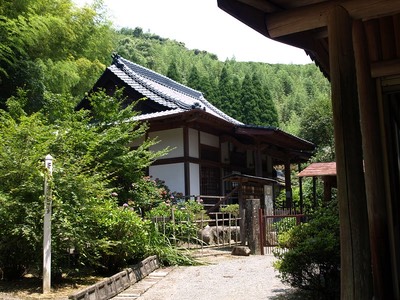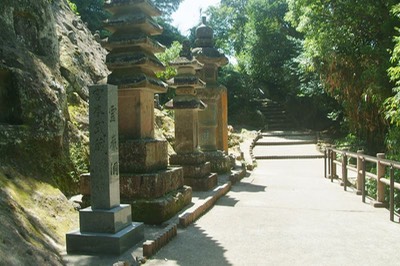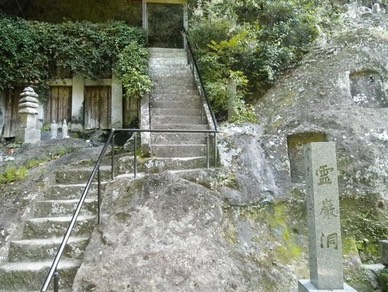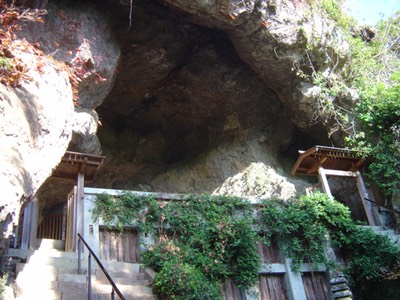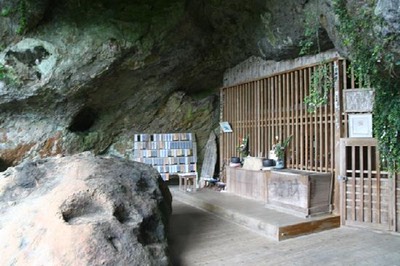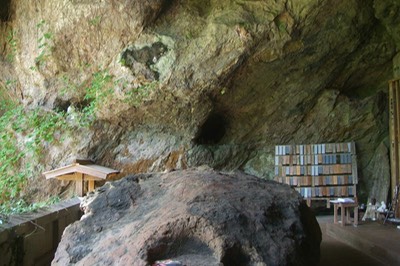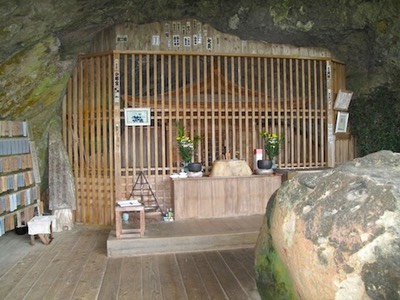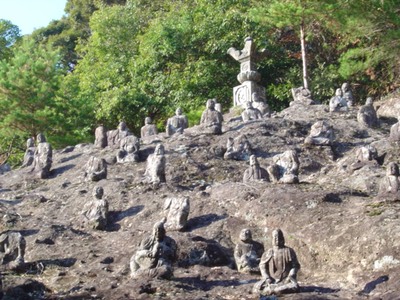The most fascinating and at the same time intriguing site connected to Musashi is undoubtedly the Reigan Cave, or Reigandō (霊厳洞) in Japanese. The cave, situated on Mount Iwato is the cave Musashi visited frequently during his last years in the castle town of Kumamoto to write his magnum opus, the Gorin no sho, the Book of Five Rings. The name Reigan is comprised of the two characters of rei (霊), or spirit, and gan, (厳), or great rock, which is also the first character of Ganryū Island, the island on which Musashi fought his celebrated duel with Sasaki Kojirō.
Mount Iwato is situated just west of Kumamoto castle. Musashi, at this time, was living on the grounds of Kumamoto castle, where, with the blessing of Hosokawa Tadatoshi, he had settled to spend his last days. Mount Iwato is the location of the Two years earlier, Hosokawa Tadatoshi had passed away and it is believed that it was on the request of his son, Hosokawa Mitsunao (1619–50), that Musashi recorded the secrets of his school of swordsmanship.
The Reigan Cave was already a place of pilgrimage in Musashi’s days, for the cave is situated on the grounds of the Unganzenji, a temple belonging to the Sōtō sect. The temple is said to have been founded during the Northern and Southern Courts period (1334–1392) by the Chinese monk Dōng Líng Yǒng Yú (Tōryō Eiyo, in Japanese), who visited Japan on the invitation of Ashikaga (1306–1352).
At the rear wall of the cave, thoroughly hidden from view behind two latticed screens, is a stone image of the Kannon Bosatsu (Avalokitesvara), the Bodhisattva of Compassion. She is the temple’s principal object of worship, by virtue of which the Reigan Cave is essentially its inner sanctum, or oku no in.
The Reigan Cave is believed to have been visited by the Heian poetess Higaki. Once a courtesan at the Heian court known for her wanton sensuality, she fell on hard times following a riot in which her house was looted and burned. She took up living in an old shack along the Shira River, where she was visited by the then governor, Fujiwara no Okinori. Asked to bring him some water, she devised the poem:
年ふれば
我が黒髪も
白河の
みづはくむまで
老いにけるかな
Since the years have passed
my black hair, too,
Like the white river
Shirakawa
Remarkably, the Reigan Cave is one of the few places referred to by Musashi in his own writings. In the Earth Scroll of his Book of Five Rings, he states that he “came to Mount Iwato in the province of Higo to write.” Hence it was here, amid the quit hush of the cave’s interior that the swordsman found the inspiration for write his seminal work. That much, too, is borne out by the Bushū denraiki and the the Bukōden which Thus the Bushū denraiki describes the moment Musashi first took up his brush:
寛永二十年、武州六十歳、肥の後州岩戸山に登り、觀世音菩薩を拜し、佛前に於て、天道と觀世音を鏡として、十月十日の寅の一天に筆を執て、兵書五巻を記せる。地水火風空と號す.
In the twentieth year of Kanei [1643], at the age of sixty, Musashi climbed Mount Iwato where he worshipped the Kannon Bosatsu. And on the tenth day of the tenth month [21 November], at the third sign of the zodiac, and in the light of the Kannon and the Heavenly Way, he took up his brush and recorded the five scrolls on the art of heihō. He named them the scrolls of earth, water, fire, wind, and heaven.
Though this would suggest that Musashi wrote his lengthy work in a single burst of inspiration, it is more likely that he did so over the course of several months, if not years. This seems to be borne out by the Bukōden which describes how, even after one-and-a-half year he still sought out the Reigan Cave, even though he was now on the brink of death:
正保二年之春、武公病なり。府中の紛囂を厭ひ、岩戸に至り、霊岩洞の裏に入り、静に終命の期了せんんとす。
In the summer of the second year of Shōhō [1645], Musashi fell ill. Finding the hustle and bustle of town disagreeable, he went up to Mount Iwato, where he entered the Reigan cave so that he might quietly await his end.
Today, the Reigan Cave has become the prime destination of Musashi aficionados around the world. The sense of mysticism is enhanced by a multitude of sitting Buddhist statues that grace the flank of the mountain, which at the same time lend it a somewhat eery quality. Donated to the temple by a certain Fuchida Yagihei, a merchant from Kumamoto who lived during the early nineteenth century, they represent the gohyaku rakan, or the Five Hundred Enlightened Followers of Buddha.
Any queries of remarks? Launch or join a discussion at our new FORUM
